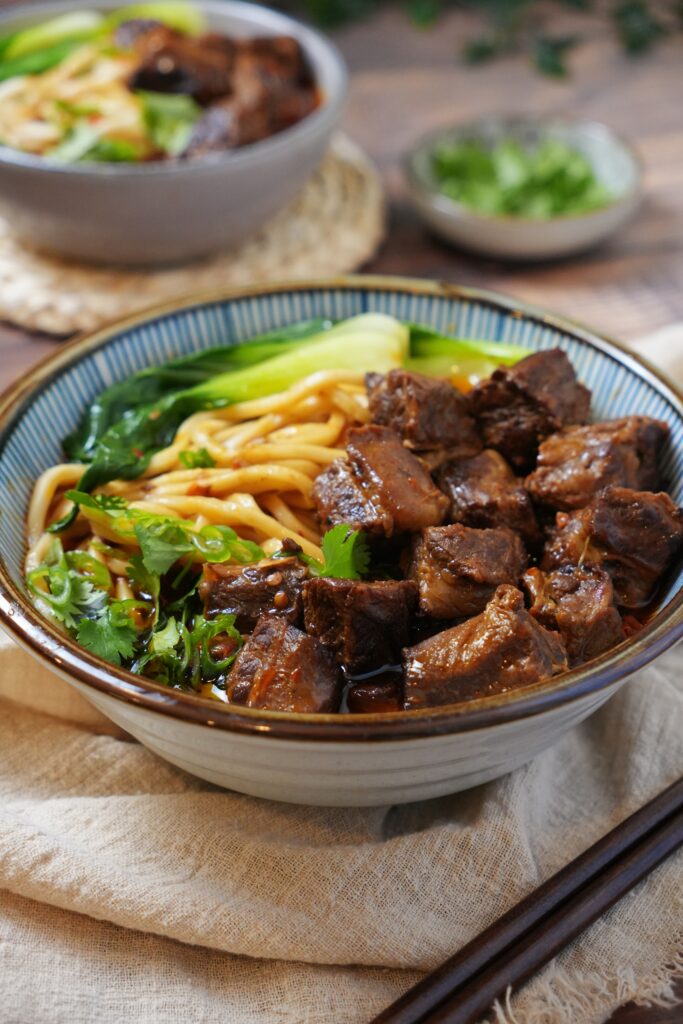Chinese Braised Beef Noodle Soup (红烧牛肉面)
There’s something about a bowl of braised beef noodle soup that soothes the soul and satisfies the senses. For me, it’s more than just a dish. It’s a comforting embrace on days when I need it the most. Recently, while battling a stubborn flu, I found myself craving nothing but this warm, flavorful meal. It reminded me why this soup has a special place in the hearts of so many.

Love beef dishes? Try our mouthwatering Chinese Braised Beef Back Ribs or warm up with hearty Instant Pot Chinese Beef Stew.
Complex Flavor That’s Easy to Achieve at Home
Chinese braised beef noodle soup is one of those dishes that feels like a hug in a bowl. The broth is rich and deeply layered, with caramelized sugar, fragrant aromatics, and slow-simmered beef that turns melt-in-your-mouth tender. A spoonful of this soup is never boring—especially with the addition of Doubanjiang, a spicy fermented bean paste that adds just the right amount of heat and complexity.
But here’s the best part: you don’t need to do much to achieve this incredible depth of flavor. The magic comes from letting the ingredients work together—the warmth of the spices, the umami from soy sauce and Doubanjiang, and the slow simmer that brings everything to life. It’s simple, comforting, and always a staple in my family’s kitchen.

Winning Tips
Which Beef to Use?
For this braised beef noodle soup, I used beef finger meats, which have beautiful marbling and higher fat content, resulting in a much more tender and juicy outcome.
You can also use beef chuck, shank or brisket. Beef chuck is more cost friendly and cooks faster. Beef shank contains connective tissue, which gives the broth a smooth and gelatinous texture. Beef brisket is marbled with fat, making it tender and juicy, though you may need to cook it longer for the best results.

Why Use Caramelized Sugar?
The Chinese braised beef noodle soup used the classic Chinese Red-cooked Dishes (Hong Shao) technique to create the deep, rich flavor and glossy appearance. In red-cooked dishes, caramelized sugar is a key component. The process of caramelizing sugar in this context is not only about adding subtle sweetness but also contributing to the distinctive color and flavor profile.
Key to Success in Caramelizing Sugar for Red-cooked Dishes:
- Control the Heat: The sugar should be melted over low to medium heat, and you need to watch it closely to prevent it from burning. Once the sugar starts melting, it can go from golden to burnt very quickly.
- Do Not Stir: Stirring may cause the sugar to crystallize. Be patient and avoid rushing the process.
- Timing: Once the sugar has reached a golden brown color (not too dark!), it’s crucial to add the other ingredients (like soy sauce and rice wine) right away to prevent the sugar from becoming too dark or bitter.



Using Hot Water is Important
Using hot water when cooking meat is key because it prevents shock to the meat. Adding cold water to hot meat can cause the proteins to seize up, making it tougher. By using hot water, the meat’s temperature stays consistent, helping it cook more evenly and stay tender.

Looking for more authentic recipes? Be sure to follow me on Pinterest, Instagram, Tiktok and Youtube!

Chinese Braised Beef Noodle Soup
Ingredients
- 1 kg Beef Beef finger meat, or use beef chuck, shank, or brisket (please see notes above for their characteristics)
- 2 tbsp neutral oil
Aromatics:
- 1 tbsp Ginger 5 slices
- 3 stalks Green onion
- 1 Star anise
- ⅓ Cinnamon Stick
- 3 Bay leaves
Condiments:
- 2 tbsp Sugar for caramelizing
- 2 tbsp Shaoxing wine
- 2 tbsp Soy sauce
- 1 tsp Dark soy sauce
- 1½ tbsp Doubanjiang 豆瓣酱
- 1 tbsp Oyster Sauce
- To taste Black pepper
- 2 cups Hot water Add more if needed
- To taste Salt
Serve with:
- Noodles
- Bok Choy
Instructions
Blanch the Beef
- Place the beef in a large pot and cover with cold water. Bring to a boil over medium-high heat.
- Once boiling, skim off any impurities. Remove the beef and discard the water.
- Optional: Rinse the beef under hot or warm water. Avoid rinsing with cold water.
Caramelize the Sugar and Sear the Beef
- In a clean, dry pan over medium-low heat, heat oil and sugar to allow it to melt. Do not stir; just let it gradually melt and turn golden brown. Once it reaches a golden amber color, add the beef back in.
- Add in ginger, green onion, star anise, cinnamon stick and bay leaves. Turn up the heat and stir-fry for a minute.
Add Aromatics and Condiments
- Add a splash of Shaoxing wine, cook until the liquid evaporates.
- Make a space in the middle and add Doubanjing, stir fry it and then mix everything together. Cook for 1 minute.
- Add soy sauce, dark soy sauce, oyster sauce and black pepper. Mix well.
Braise the Beef
- Add hot water to cover the beef.
- Cover the pot and simmer on low heat for about one hour, or until the beef is tender and easily shreds.
Prepare Noodles and Bok Choy
- While the beef is braising, cook your noodles according to the package instructions.
- Lightly blanch bok choy in boiling water until just tender (about 2 minutes).
Assemble the Soup
- Place cooked noodles and bok choy in individual bowls, then pour the beef and hot broth over the top.
- Garnish with fresh cilantro, green onions, and chili (if desired). Serve hot and enjoy!







This recipe is so, so delicious! I’ve never cooked braised beef noodles before and Crystal’s instructions were so clear that I managed to nail it the first time I tried 🥰 thank you Crystal for sharing such a wonderful recipe to the world! I’m definitely going to make it again, this time for family and friends 🤩❤️
Thank you so much Samantha!! I’m so happy to hear that you enjoyed it and that the instructions were helpful. It means a lot that you’re planning to make it again for your family and friends. I hope they love it just as much! ❤️🍜
There is no mention of oil in the recipe, how much should be used?
Hi there! Thank you for bringing this up! I’ve updated the recipe — it uses around 2 tablespoons of neutral oil. Sorry for the inconvenience!